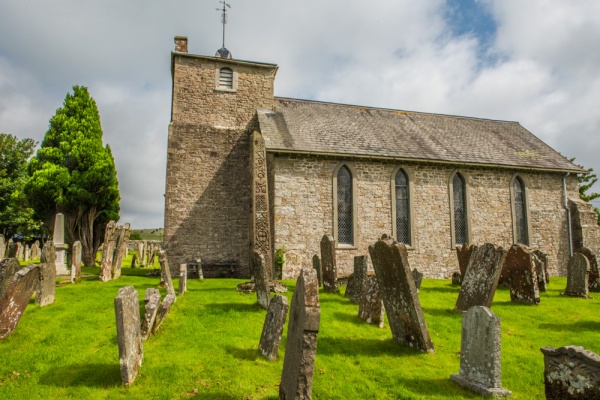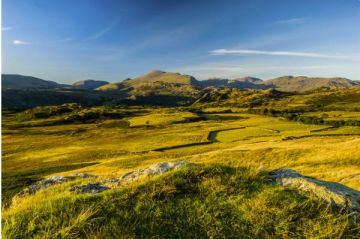
In a curious way, the medieval church of St Cuthbert at Bewcastle owes its existence to Emperor Hadrian. When Hadrian began to build his famous wall in AD 122 he also constructed a defensive perimeter of three forts. One of the three forts was erected at Bewcastle, where the Romans took advantage of the natural plateau above the Kirk Beck and the fact that a pre-existing shrine to the god Cocidius stood there.
The Romans made a practice of co-opting existing native Gods and holy site, and that was the case at Bewcastle. They even called the Fort 'Fanum Cocidia', which translates as 'The Temple of Cocidius'.
The fort was abandoned in the 4th century, but it seems very likely that the site continued to have some religious significance. a small monastic community may have continued the legacy begun before the coming of the Romans. In the late 7th century the famous Bewcastle Cross was erected.
Around 1277 a small stone church was built beside the cross, using stones from the Roman fort. Very little remains from that 13th-century building, though the east end of the church has survived.

The border region between England and Scotland was a rough and violent area throughout the medieval period. Many of the local families on both sides of the border engaged in regular 'reiving', cattle raids that often descended into violent conflict.
A local story says without too much exaggeration that only the local women were buried in St Cuthbert's churchyard;' the men were all hanged in Carlisle. In fact, William Patrick, who served as rector of Bewcastle from 1548-1555, was a well-known reiver, aided by his curate, John Nelson.
If you examine the gravestones in the churchyard you will run across famous reiver names like Armstrong, Nixon, and Routledge. The oldest gravestone dates to 1698 and belongs to a Routledge. It shows a fascinating series of carvings, with a man turning his back on a skull and crossbones, only to see an hour-glass with its sand running out. The figure has his arms thrown up in alarm as he sees the hours of his life slipping away. Beneath the figure are a spade and a fork, tools used by the sexton to dig graves.
It is well worthwhile exploring the churchyard, just to see the wonderful 17th and 18th-century carvings on the gravestones.
In 1703 Bishop Nicholson of Carlisle visited Bewcastle and recorded that it had no plaster on the walls, no royal coat of arms, and no bell to summon worshippers. Even worse, 'The Font wants a pedestal, and looks like a Swine's Trough'. The 'swine's trough' font bowl is preserved on a window ledge of the present church.

The simple building that Bishop Nicholson complained of was rebuilt in 1792. The west end was shortened by 17 feet, the roof was raised, and a west tower was added. The church was rebuilt again in 1901.
It is a simple rectangular building with no division between the nave and chancel. As mentioned, the oldest part of the church is the east wall. In the wall is a triple lancet window in Early English style. At the west end is a wooden gallery, presumably installed during the 1792 restoration, at a time when galleries were fashionable.

The Bewcastle Cross
Most people come to Bewcastle to see the cross, which stands in the churchyard by the south-west corner of the church. The cross is an astonishing work of art, carved with a combination of sacred images and an inscription to Alefrith (or Alefrid), son of King Oswi, the man who convened the Synod of Whitby in AD 664.
Every side of the cross is carved with intricate Celtic interlace patterns. The quality of the workmanship is matched only by the even larger cross at Ruthwell, in Dumfries-shire. What is fascinating is that it appears that the cross was originally painted, and would have stood out even more than it does today.
In the churchyard is a free exhibition housed in an old stone building. Here you can find out more about the history of Bewcastle, the Cross, the church, and the violent heritage of the Border Reivers.
The church is open to visitors and has been open every time I visited. The church is not of great architectural interest, but it is well worth exploring, especially if you've already made the journey to find the cross, the Roman fort, and the medieval castle just beyond the churchyard!
About Bewcastle
Address: Bewcastle,
Cumbria,
England, CA6 6PS
Attraction Type: Historic Church
Location: On a minor road 10 miles north of Brampton
Website: Bewcastle
Location
map
OS: NY565745
Photo Credit: David Ross and Britain Express
NEARBY HISTORIC ATTRACTIONS
Heritage Rated from 1- 5 (low to exceptional) on historic interest
Bewcastle Cross - 0 miles (Historic Building) ![]()
Leahill Turret and Piper Sike Turret (Hadrian's Wall) - 6 miles (Roman Site) ![]()
Birdoswald Fort and Hadrian's Wall - 6 miles (Roman Site) ![]()
Harrows Scar Milecastle (Hadrian's Wall) - 6.1 miles (Roman Site) ![]()
Pike Hill Signal Tower (Hadrian's Wall) - 6.1 miles (Roman Site) ![]()
Bank's East Turret (Hadrian's Wall) - 6.1 miles (Roman Site) ![]()
Willowford Roman Bridge (Hadrian's Wall) - 6.2 miles (Roman Site) ![]()
Hare Hill (Hadrians Wall) - 6.2 miles (Roman Site) ![]()













